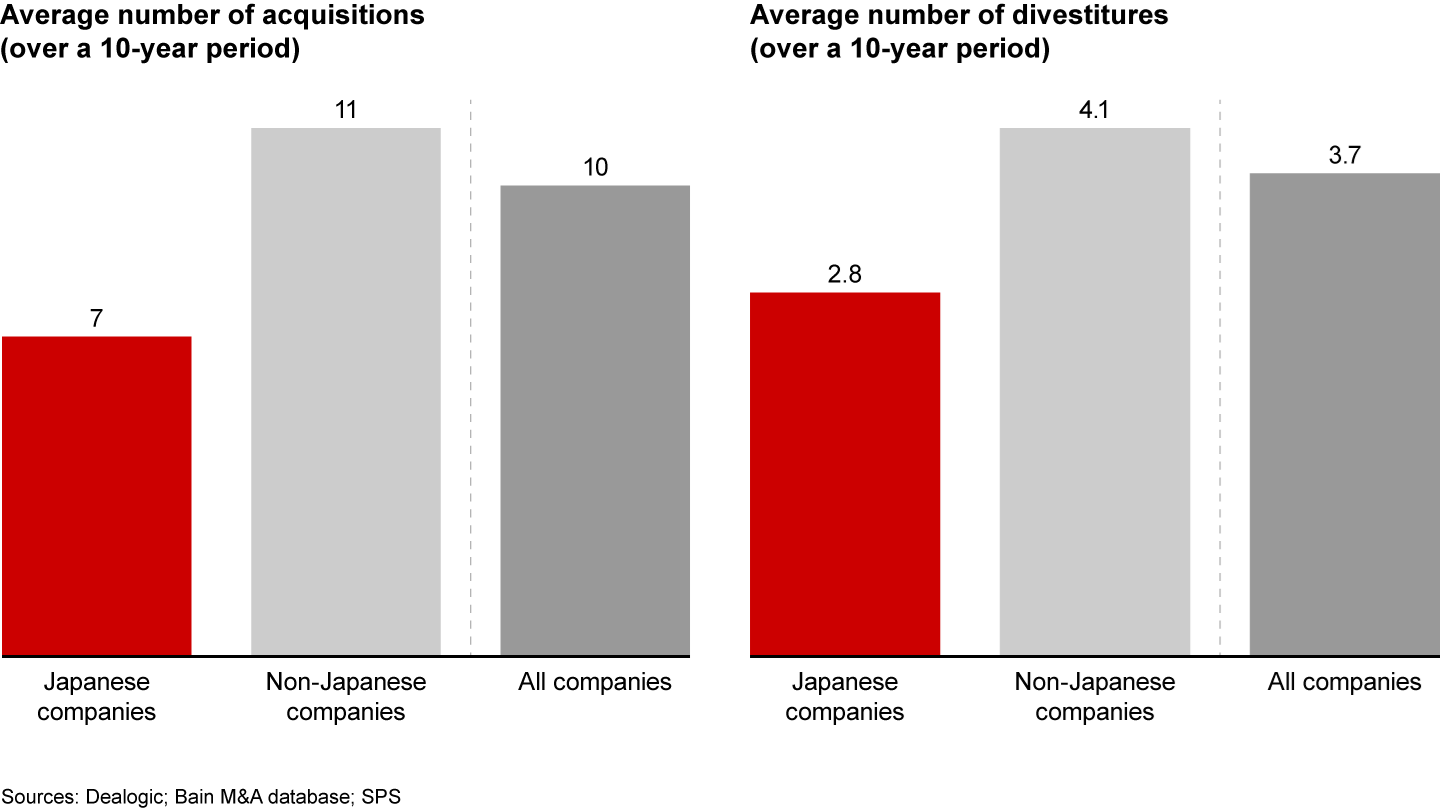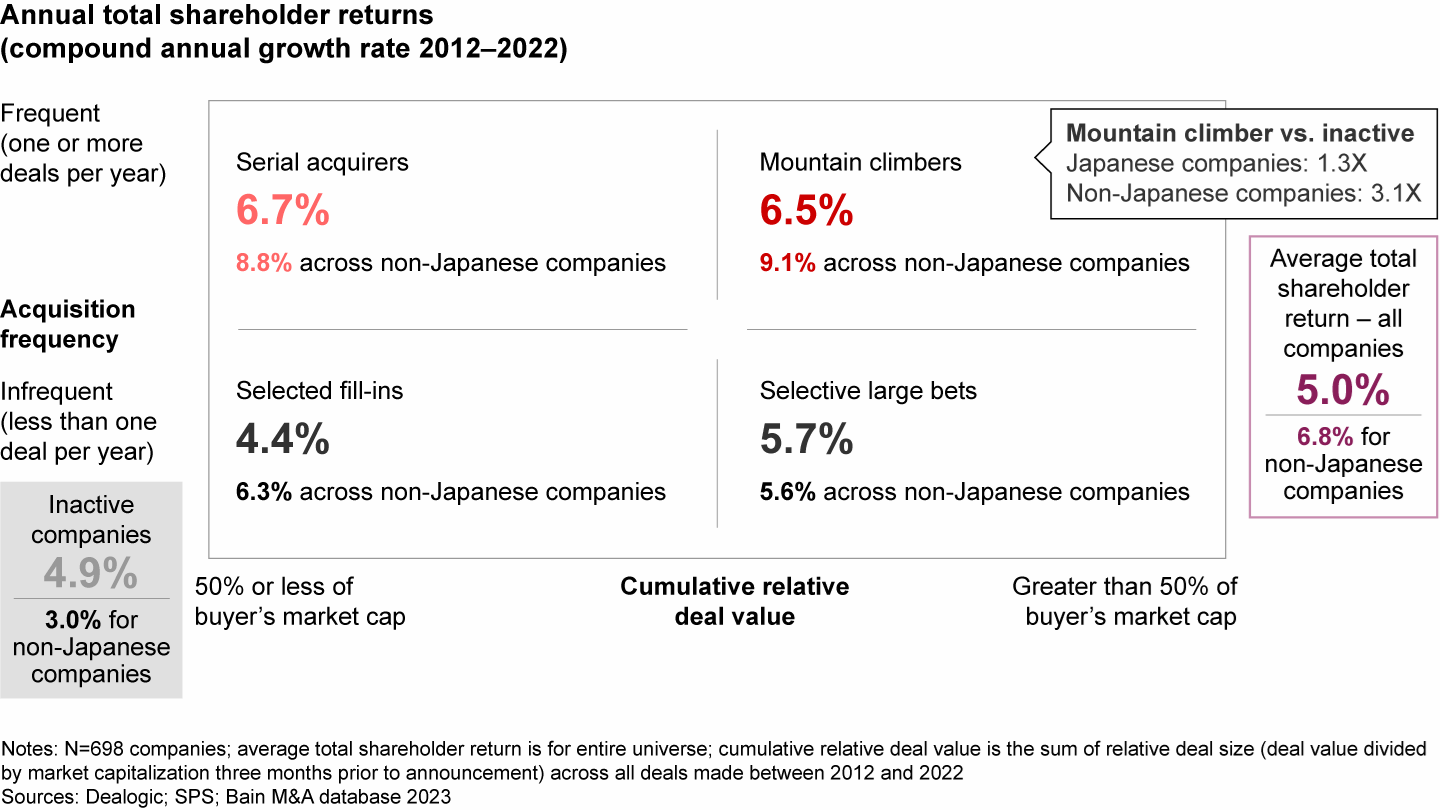M&A Report

En Bref
- Global M&A activity declined, but Japan’s deal value increased by 23% year over year, delivering roughly $123 billion in 2023.
- Motivation for corporate M&A included regulatory and investor pressure to improve company valuations.
- Private equity deals, which play a critical role in the country’s M&A ecosystem, reached historic levels.
- Companies missing out on the full value of M&A can learn from winners that have benefited from their deal experience.
This article is part of Bain's 2024 M&A Report.
While the rest of the world played catch-up, Japan experienced significant growth as companies addressed regulatory and investor pressure to do more deals in 2023. A total of $123 billion in corporate M&A deal value was amassed in 2023, up 23% vs. the prior year. A record level of acquisitions was also made by private equity investors in 2023—more than anywhere else in Asia. But can Japanese companies maintain enough activity to build the M&A muscle that will enable them to achieve the same level of total shareholder returns (TSRs) that companies in other regions achieve through M&A?
Japan’s economy is uniquely well positioned for growth in M&A. Low interest rates make deals relatively less expensive than elsewhere in the world. Valuations, on the whole, are low, too, partly because of conglomerates’ general reluctance to sell noncore assets. On top of that, companies are sitting on substantial levels of cash—to the point at which the government and investors are both applying pressure to do deals. The Tokyo Stock Exchange set a threshold for all companies to improve their price-to-book ratio to a multiple of at least one, bringing the issue of M&A to the top of corporate leaders’ agendas. And in the case of Toshiba, 2023 was the year that a deal led by the buyout fund Japan Industrial Partners finally paved the way for the embattled industrial conglomerate to go private after years of activist shareholders demanding a sale.
These factors may have buoyed M&A in Japan this year, with deals such as Nippon Steel’s December bid to buy US Steel for $15 billion. But it’s clear that companies need to do more to streamline portfolios and adapt to meet the pace of transformation across industries. Some have proven they are up to the challenge—for example, Hitachi has sold off nearly $20 billion worth of businesses over the past five years (including more than $1.8 billion in 2023 alone). Still, despite the steady level of overall deal value, most Japanese companies are less active in M&A when compared with their counterparts in other regions (see Figure 1). They can learn from a consistent finding in our decades-long research on M&A performance—namely, the more deals a company does, the better they will get at doing them.
Japanese companies are less active in both acquisitions and divestitures


Bain studies of M&A’s contribution to TSRs since 2004 show that frequent acquirers gain a performance advantage over infrequent or inactive acquirers, reflecting the increasing sophistication of their M&A capabilities over time. Frequent acquirers deploy a repeatable model across the full M&A process—that is, strategy, screening, diligence, and integration—to maximize value creation, but because Japanese companies have been both less active and less mature in their M&A capabilities than their global peers, the TSR benefits are muted as well. Even the most active Japanese companies—we call them “mountain climbers”—are not yet achieving the advantage of frequent and material acquirers in other regions. For example, mountain climbers in Japan yielded an average TSR 1.3 times the TSR of inactive Japanese companies over the years 2012 to 2022. By comparison, non-Japanese mountain climbers saw returns that were on average 3.1 times that of inactive companies (see Figure 2). It’s a situation that will change as Japanese acquirers begin to advance along their journey of building M&A muscle.
Japanese frequent acquirers deliver higher total shareholder returns, but the lift is lower than in other countries


Some companies are setting the pace for Japan’s ascension in the M&A world. Sony has long exemplified both the benefits of frequent M&A and the capabilities needed to do it well. M&A has been critical in the company’s strategy to become one of the largest game publishers in the world. Sony set a budget for acquisitions as part of its publicly announced two-year spending plans, and the company has a clear vision for how M&A will help achieve defined strategic goals and add value post acquisition. Acquisitions across game development companies and first-party studios, including the purchase of Firewalk Studios in 2023, have enabled a vertical integration strategy that, in combination with other frequent acquisitions across its portfolio of businesses, have fueled continuous growth. This is evidenced in public market perception as well. Sony’s 10-year TSR hovers above 20%.
Companies hoping to replicate Sony’s success must double down on three key activities.
- Reexamine business portfolios, and align on M&A strategy. Companies need to answer two critical questions: What noncore assets can be sold to fuel growth in other areas? And where can M&A be a catalyst for transformation, meet new consumer needs, or otherwise help achieve strategic goals?
- Focus on cultural aspects of integration. Particularly in cross-border acquisitions, cultural aspects are a critical influence on value creation. Japanese companies historically have been either too hands-off or too active in pushing their own culture. A cross-pollination approach to bring strengths from each side is essential.
- Create a feedback cycle. Companies tend not to look back and evaluate past failures—for instance, a deal that was priced too highly or one in which there was a particularly slow post-merger integration. There’s often hesitation because it could lead to criticism of the deal team or executives who pursued the deal. But senior leadership should view post-deal assessment as an important management agenda item that will identify key learnings for future deals.